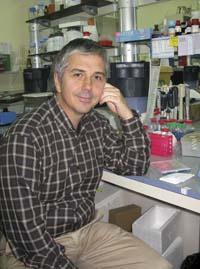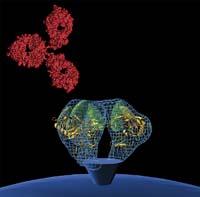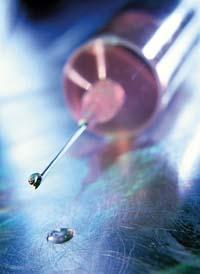From medicines to vaccine

In addition to replacement treatments, the Leioa Biophysics Unit is working on getting the vaccine.
"The best known example of the lack of success of the vaccine today is the vaccine against the fatal AIDS viral agent," which can be read in the article "Strategies of the virus to invade cells" of Elhuyar magazine in January 1996. The author, José Luis Nieva, is a researcher who explained, among other things, the need to know the structure of the cell membrane to prevent the virus from accessing the cell from it.
Almost fifteen years later, neither Nieva's phrase nor explanation has lost relevance. Even more: Nieva herself continues to investigate the infectious mechanism of the AIDS virus to create strategies against it.
He works in the Leioa Biophysics Unit, in collaboration with local researchers and other international groups. One of its objectives is to design compounds more efficient than the antiretrovirals currently used in the treatment of AIDS. According to Nieva, high doses must be used with current antiretrovirals because "the targets are intracellular". Therefore, these antiretrovirals must pass through the cell membrane, which makes the doses high. "To avoid it, extracellular targets are now sought. That's what we are, that the virus is the target," said Nieva.

Thus, the interaction between the spiny proteins that HIV has abroad and the membrane of the cell that infects it is being investigated. Spine proteins are the keys that HIV uses to introduce them into the cell and must be inserted into certain locks. Therefore, it infects different types of cells. Nieva has explained in detail what type of cells and where the interaction occurs: "The AIDS virus specializes in lymphocytes, due to the presence of some markers. One of the markers is the CD4 receiver and two are CCR5 and CXCR4".
These markers are therefore the locks; if the interaction between them and the keys is difficult, that is, the spiny proteins, the virus cannot enter the cell. In fact, there are people with their own immunity to AIDS. These people have a CCR5 mutation: With the lock mute, HIV cannot access lymphocytes. Researchers want to get something similar.
But it's not easy. For starters, not all locks are the same. Nieva said that "you cannot use a target if it is not redundant. That is, you cannot inhibit an element of the cell if it does not have a substitute, but the cell dies." That is why the CD4 receiver cannot be used because it has no substitutes. Instead, CCR5 has it, as demonstrated by people who have it mutated. The same goes for the CXCR4 marker. "Therefore, inhibitors can develop against both, so that spine protein cannot interact with the receptor and HIV cannot enter the lymphocyte." In fact, there is already a medicine maraviroc that blocks CCR5, but it does not work in all cases.
Armor and antibodies
Another way to prevent entry is to "wear a shell" to the cell. This strategy, developed in the Biophysics Unit, consists in the transformation of the cell membrane. In fact, HIV enters a certain area of the membrane, the sphingolipid zone. Researchers have inhibited the enzyme that introduces a double bond into sphingolipids. As a result, the membrane is governed and the HIV and cell membrane cannot be fused. That is, the virus cannot cross the breastplate.

In any case, Felix Goñi, director of the Biophysics Unit and head of the research, has warned that "it will take" to apply to therapy: "To achieve this we still have to do a lot of work and first we need someone to fund the research."
Meanwhile, researchers are working on other strategies. Nieva focuses on spiny proteins. "Spine proteins are necessary for the virus, to bind them to the cell," says Nieva. "With them it is inserted into the cell, fusion occurs and extends a pore. The aim of our work is to understand this, especially vaccination and fusion."
"Here we have two options: target spiny proteins or use them to make vaccines," explains Nieva. In fact, the immune system of the infected person generates antibodies against these proteins, which are the structures they know and consider alien. "We are in it. On the one hand, we are developing inhibitory molecules so that HIV does not integrate into the cell and, on the other, we are developing antibodies against GP41, a component of the spine protein."
Nieva confesses that she is working on basic research. They have managed to develop for the moment an inhibitor that works in the water: "The molecule we have developed takes the place of the natural binder, but we need a molecule that works in the middle of the membrane, not just in the water."

On the market there is an inhibitor called Virip. "We are working on the development of an inhibitor like him," said Nieva. He adds that there are some inhibitors that influence fusion and gives an example to one. It is called Enfuvirtide and is used in the clinic, but not in conventional treatments but in rescue therapies. He explains that these therapies are used in patients who have developed multiresistances with antiretrovirals. "Enfuvirtide is used for cleaning multiresistant blood viruses because they have no resistance to it. But we do not investigate at this stage, we try to prevent vaccination of the virus."
Immunization objective
The ultimate goal is to get the vaccine. This is accepted by Nieva, and they are also investigating. It is not easy, many antibodies have been described that occur in the infection but are not able to block the infection. Some are interesting for researchers: Nieva mentioned 2F5 and 4E10: "Especially those, there is not much more. Both are monoclonal antibodies, detected in patients' bodies and acting on the area where spinous proteins are integrated into the cell membrane."
The researchers hypothesis is that these antibodies inhibit the areas of the spine protein embedded in the membrane. Nieva has pointed out that "it is a fairly new paradigm, but we have seen it happen in nature." Therefore, it highlights the possibility of getting vaccinated with it.
The Biophysics Unit is working on the development of part of the vaccine. Antibodies add fragments of spiny proteins known to the liposomes and vaccinate rabbits to see their immune response. "We expect our immune peptide liposomes to be suitable for combining with DNA vaccines that others are developing," explains Nieva. "But it's very complicated," he said.

In addition, advances made in the laboratory rarely reach the clinic. Nieva has set an example of some hexapeptides developed there. These hexapeptides are spina gp41 inhibitors, developed in 2006 and patented in 2008. However, they have not yet been developed for the clinic. In fact, few compounds exceed the barrier.
Nieva knows it perfectly: "We have to be realistic. Of every 1,000 patented compounds, 30 reach clinical sessions, three outperform clinical sessions and only one of them advances."

Buletina
Bidali zure helbide elektronikoa eta jaso asteroko buletina zure sarrera-ontzian











